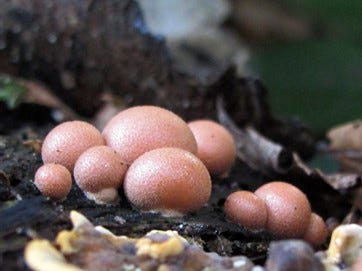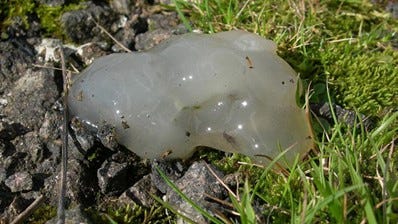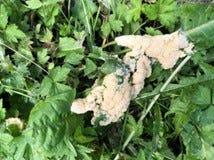Pink Blob and Dog Vomit : What on earth is that?
Saranne introduces us to the wonderful world of slime moulds
I will always remember my first slime mold.
I’d never seen the like before.
In fact I’d never even known they existed.
I wasn’t long in my current post – 6 months or so after being an Access Project Officer for 3 years so my natural history ID was a little bit rusty, but luckily my hobby is my job is my job is my hobby (very useful when furloughed for nearly 18 months and worried about ‘imposter syndrome’ on return) and I was still curious about everything as all us rangers are – especially on espying a bright pink blob – and I mean bright! Almost fluorescent on a very old fence post in Beachen Woods, Grantown-on-Spey in the Cairngorms National Park.
I was instantly fascinated – who wouldn’t be – it looked so out of place and too garish for the hazel and aspen woods I was meandering through – so of course I poked it – not expecting pink goo to spurt out all over my finger – yeah yeah I know I should’ve used a stick to poke it with…and of course in those days we didn’t all have instant cameras in our pockets and of course hadn’t thought to carry the works camera – so I played around with it for a while and then headed back to the office.
When I decided to do a blog on slime molds I really didn’t expect to find so many myself in such a short space of time. The following piccies are from the last two weeks! They must have been hungry and the weather conditions just right.
Thank the universe for the internet – inputting ‘pink blob’ into a search engine and the first thing to come up is – a truly horrible dress….however further down - we come to slime mold – really? Slime mold – what on earth is that?! And why had I not heard of these before?
Wolfs milk - Lycogala Terrestre - Picture Jeanne Debs (Flikr)
Turns out there’s a lot of them, 900 in fact. Found in all different colours; orange, pink, yellow, grey, brown except for ‘true’ green as they lack chlorophyll. One species freaked out a pal of mine when he found a deciduous tree in Laggan covered in this clear gelatinous slime. Luckily for me he had the foresight to collect a sample in a jam jar in the hope I could identify it for him. I was delighted to tell him that it was a slime mold and equally delighted to see all the nuclei within each cell. We hurried back to the tree to get a photo but all traces had vanished…
So a slime mold is a legless, brainless, unicellular creature that bands together to find food – what?! A unicellular creature coming together – how, why?
Slime mold is, in fact, a soil-dwelling amoeba which breaks down rotting vegetation feeding on bacteria, yeast, and fungus. They are usually microscopic and reproduce by releasing spores after drying out. They are harmless and some species can grow up to several square metres and masses up to 20kg!
So, the most studied slime mold in the world is the Physarum Polycephalum slime mold. A legless, brainless, single celled organism that oozes and transforms itself but can also avoid stimuli, avoid chemicals, change behaviour with climatic conditions and pass on knowledge!
They form strange and sophisticated shapes – some resemble honeycomb lattices, others blackberries. And then there’s the slime mold known as “dog vomit,” because it looks just like the stuff with yellow bile like colours. Some remain microscopic, and others grow rogue, forming bulbous masses, as long as 3-4 metres across.
For creatures without feet, they can travel incredible distances. Stephenson said one of his students identified slime molds in New Zealand that are genetically identical to groups found in the United States. How they got there is unknown. So so cool…
And although the slime mold's has no neurons throughout its entire gelatinous body, they seem to be able to solve relatively complex problems, especially if they’ll be rewarded and to be capable of memory!
Slime molds are fungi in the class Myxomycetes. These are cosmopolitan organisms that feed on bacteria, protozoa, and other tiny organisms. As is the case with other fungi, slime molds reproduce by spores. Once the spores germinate, they go through several developmental stages which eventually result in a feeding stage called a …..plasmodium……A plasmodium – what a fab word! It conjures up all sorts doesn’t it?!
It is actually ‘a multinucleate mass of protoplasm which results from the fusion of amoeba-like cells.’ So when sufficient water is available, slime molds creep or flow over many types of surfaces. They creep at a fairly fast pace and some species can actually move several feet in 24 hours.
Pic: Found in Dingwall
Most slime molds spend their days alone and unseen (microscopic). However, when food gets scarce, they slowly move towards one another to create a new structure to produce spores that will be taken to a new place by the wind.
Slime mold can show some really interesting behaviours. For instance, having fed on a nice pile of oats, the slime mold goes off to explore new territories in different directions simultaneously. When it meets itself, it knows it's already there, it recognizes it's there, and instead retreats back and grows in other directions. How? What? How can what was essentially just a bag of cellular slime somehow map its territory, know itself, and move with seeming intention.
It has been known to map and replicate the suburban railway network of Tokyo in Japan when piles of oats were placed at strategic points on a map otherwise known as actual stations!
It is a biological computer. As such, it has been mathematically modelled, algorithmically analysed. It's been sonified, replicated, simulated. World over, teams of researchers are decoding its biological principles to understand its computational rules and applying that learning to the fields of electronics, programming and robotics.
Found in Granton-On-Spey
So the question is, how does this thing work? It doesn't have a central nervous system. It doesn't have a brain, yet it can perform behaviours that we associate with brain function. It can learn, it can remember, it can solve problems, it can make decisions. So where does that intelligence lie? So inside the slime mold, there is a rhythmic pulsing flow, a vein-like structure carrying cellular material, nutrients and chemical information through the cell, streaming first in one direction and then back in another. And it is this continuous, synchronous oscillation within the cell that allows it to form quite a complex understanding of its environment, but without any large-scale control centre. This is where its intelligence lies.
So it's not just academic researchers in universities that are interested in this organism. A few years ago, the Slime Mould Collective was set up. It's an online, open, democratic network for slime mold researchers and enthusiasts to share knowledge and experimentation across disciplinary divides and across academic divides.
You can also get slime molds that are kept as pets – I’m thinking of giving some as presents to friends of mine with children! So much fun!
Found in Nethy-Bridge
But back to the ecology of slime molds – we know that they live in the soil as cells and feed on bacteria, fungi and algae but what eats them? Beetles and slugs. Since they are not toxic anything can eat them. Although they may be found all over the world even in the Artic they don’t really like cold climates. Slime molds are incredibly important in the recycling of nutrients which is very important to how the earth functions. Oh and I nearly forgot – they can survive space too – currently 3 years so far……
Found in Cairngorms
Saranne Bish - Countryside Ranger for Badenoch, Strathpey and Nairnshire.
Saranne Bish is a consummate communicator and empathetic High Life Higland Ranger, with a life devoted to environmental stewardship. Her transition in 2002 from Ecological Surveying to Countryside Ranger for Nairn, Badenoch, and Strathspey marked a significant shift in her career. Saranne excels in educating and engaging with diverse audiences about the natural world, blending scientific knowledge with a warm, accessible approach. Her passion for conservation is matched by her skill in inspiring others, fostering a collective commitment to protecting our planet's fragile ecosystems. Her ability to connect with people and nature alike makes her a true advocate for the environment.










